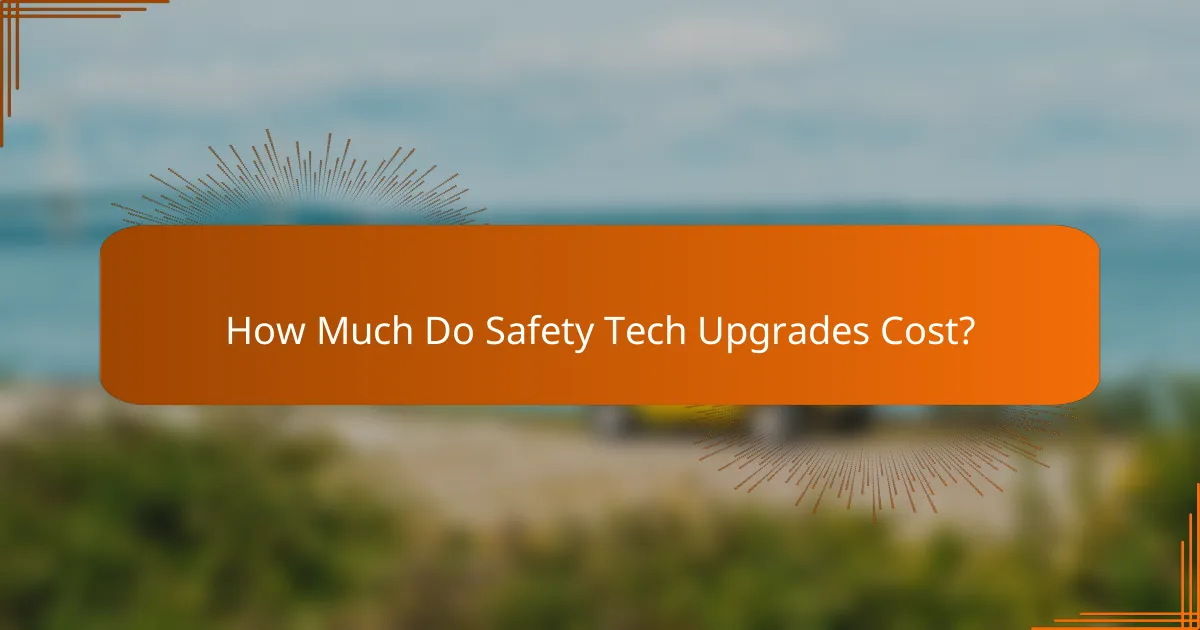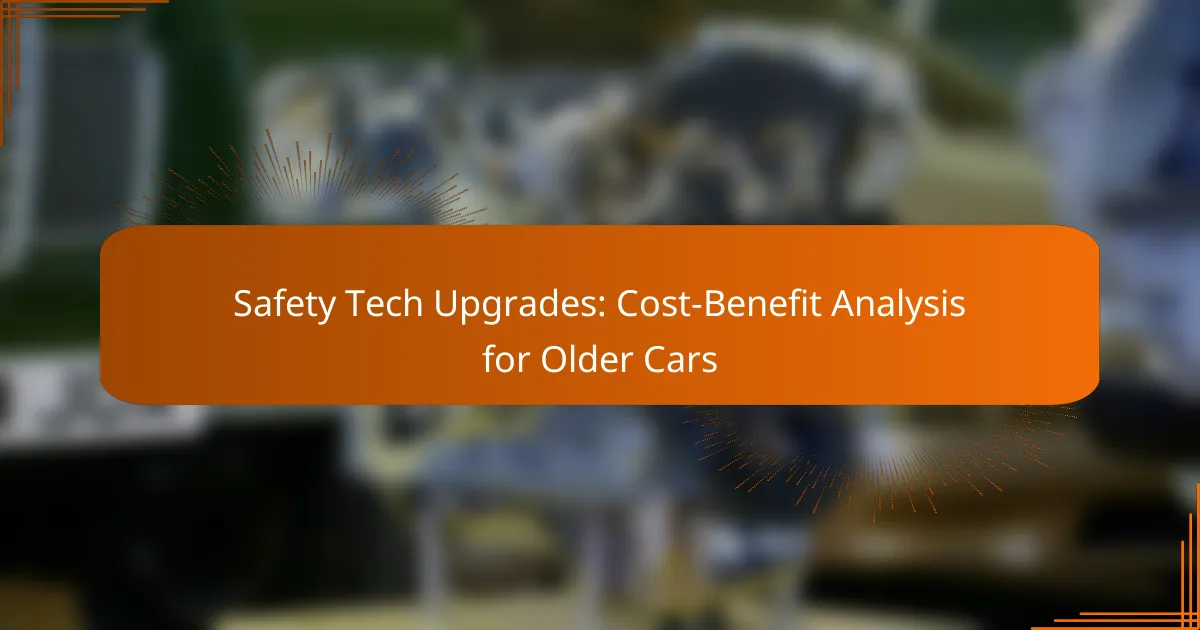As older cars age, integrating modern safety technology becomes essential for enhancing vehicle safety and driver confidence. Key upgrades such as advanced driver assistance systems and automatic emergency braking can significantly reduce the risk of accidents. While the costs of these upgrades can vary, understanding their benefits can help car owners make informed decisions that improve both safety and resale value.

What Are the Key Safety Tech Upgrades for Older Cars?
Key safety tech upgrades for older cars include advanced driver assistance systems, backup cameras, blind spot monitoring, lane departure warning systems, and automatic emergency braking. These technologies enhance vehicle safety by providing additional support to drivers, helping to prevent accidents and improve overall road safety.
Advanced Driver Assistance Systems (ADAS)
Advanced Driver Assistance Systems (ADAS) encompass a range of technologies designed to aid drivers in various situations. These systems can include adaptive cruise control, collision avoidance, and traffic sign recognition. Upgrading to ADAS can significantly enhance safety by reducing human error and providing real-time feedback.
When considering ADAS for an older car, evaluate compatibility with your vehicle’s existing systems. Installation costs can vary widely, often ranging from a few hundred to several thousand dollars, depending on the complexity of the system and the vehicle model.
Backup Cameras
Backup cameras are essential for improving visibility when reversing, helping to prevent accidents with pedestrians and obstacles. They provide a clear view of the area directly behind the vehicle, often displayed on a dashboard screen. Many newer vehicles come equipped with this feature, but it can be added to older models as well.
Installation of a backup camera typically costs between $100 and $500, depending on the type of camera and installation complexity. Ensure that the camera meets local regulations, as some regions mandate their use in new vehicles.
Blind Spot Monitoring
Blind spot monitoring systems alert drivers to vehicles in their blind spots, reducing the risk of lane change accidents. These systems use sensors to detect nearby vehicles and provide visual or audible warnings. This upgrade is particularly useful for larger vehicles that have more significant blind spots.
Adding blind spot monitoring can cost anywhere from $200 to $1,500, depending on the technology used and the vehicle. It’s crucial to choose a system that integrates well with your car’s existing electronics for optimal performance.
Lane Departure Warning Systems
Lane departure warning systems help prevent unintentional lane changes by alerting drivers when they drift out of their lane without signaling. This technology typically uses cameras to monitor lane markings and can provide visual or tactile feedback. It is especially beneficial for long-distance drivers or those who may be prone to distractions.
The cost to install a lane departure warning system can range from $300 to $1,000. When selecting a system, consider features like lane-keeping assist, which actively helps steer the vehicle back into the lane.
Automatic Emergency Braking
Automatic emergency braking (AEB) systems detect potential collisions and automatically apply the brakes if the driver does not respond in time. This technology can significantly reduce the severity of accidents or prevent them altogether. AEB is particularly effective in urban settings where sudden stops are common.
Installation costs for AEB systems can vary widely, typically falling between $500 and $2,000. Ensure that the system is compatible with your vehicle’s braking system and meets any relevant safety standards in your area.

How Much Do Safety Tech Upgrades Cost?
Safety tech upgrades for older cars can vary significantly in cost, typically ranging from a few hundred to several thousand dollars depending on the technology and installation complexity. Understanding these costs helps car owners make informed decisions about enhancing their vehicle’s safety features.
Average Costs for ADAS Installation
The installation of Advanced Driver Assistance Systems (ADAS) generally costs between $1,000 and $3,000. This price can vary based on the specific systems being installed, such as lane departure warnings or adaptive cruise control. Labor costs and the vehicle’s make and model also play a significant role in the overall expense.
Some aftermarket ADAS packages may be available for less, but they might not integrate seamlessly with older car models. It’s essential to research and choose systems that are compatible with your vehicle to ensure optimal functionality.
Cost of Backup Cameras
Backup cameras can range from $100 to $500, depending on the quality and features. Basic models provide a simple view of what’s behind the vehicle, while more advanced options may include guidelines or sensors that alert the driver to obstacles. Installation costs can add another $100 to $200 if professional help is needed.
Many states in the U.S. have regulations requiring backup cameras in new vehicles, but retrofitting older cars can enhance safety significantly. Consider investing in a model that meets current standards for better performance.
Blind Spot Monitoring System Pricing
Blind spot monitoring systems typically cost between $500 and $1,500 for installation. The price depends on whether the system uses sensors or cameras and the complexity of the installation process. Some systems may also offer additional features, such as lane-keeping assistance, which can increase the overall cost.
When selecting a blind spot monitoring system, ensure it is compatible with your vehicle’s existing electrical systems to avoid additional modifications. Researching user reviews can also help identify reliable options.
Factors Influencing Upgrade Costs
Additionally, brand reputation and warranty offerings can affect pricing. Investing in reputable brands may provide better long-term reliability, while cheaper options might lead to higher maintenance costs down the line. Always compare multiple quotes and consider the total cost of ownership when making decisions.

What Are the Benefits of Upgrading Safety Tech?
Upgrading safety technology in older cars can significantly enhance vehicle safety, improve resale value, and potentially lower insurance costs. These upgrades not only protect drivers and passengers but also contribute to a more enjoyable driving experience.
Improved Driver Safety
Upgrading safety technology can lead to a substantial increase in driver safety. Features such as advanced driver-assistance systems (ADAS), including lane departure warnings and automatic emergency braking, help prevent accidents by alerting drivers to potential hazards.
Investing in these technologies can reduce the likelihood of collisions, making the roads safer for everyone. Many modern safety features are designed to work seamlessly, providing real-time feedback and assistance to drivers.
Increased Vehicle Resale Value
Adding modern safety tech can boost the resale value of an older vehicle. Buyers are increasingly looking for cars equipped with the latest safety features, which can make your vehicle more attractive in a competitive market.
For instance, a car with upgraded safety systems may sell for several thousand dollars more than a similar model without these enhancements. This investment can pay off significantly when it’s time to sell or trade in the vehicle.
Insurance Premium Discounts
Many insurance companies offer discounts for vehicles equipped with advanced safety features. Upgrading your car’s safety technology can lead to lower premiums, as insurers recognize the reduced risk associated with these enhancements.
Discounts can vary widely, but it’s common to see reductions ranging from 5% to 20% on premiums. Contact your insurance provider to inquire about specific discounts available for upgraded safety tech.
Enhanced Driving Experience
Modern safety technologies not only protect but also improve the overall driving experience. Features like adaptive cruise control and blind-spot monitoring make driving more convenient and less stressful, especially on long trips or in heavy traffic.
These upgrades can lead to a more relaxed driving environment, allowing drivers to focus more on the road and less on potential hazards. The combination of safety and comfort can transform how you feel about your daily commute.

How to Evaluate Cost-Benefit for Upgrades?
To evaluate the cost-benefit of safety tech upgrades for older cars, consider the potential savings in insurance, the increase in resale value, and the overall condition of the vehicle. A thorough analysis will help determine if the investment is worthwhile based on your specific circumstances.
Assessing Vehicle Age and Condition
The age and condition of your vehicle significantly influence the decision to upgrade safety technology. Older cars may lack modern safety features, but if the vehicle is in good mechanical condition, upgrades can enhance its longevity and safety. Assessing factors like mileage, wear and tear, and existing safety features is crucial.
Consider the cost of repairs versus the cost of upgrades. If your car requires extensive repairs, investing in upgrades may not be practical. A vehicle that is well-maintained and has a solid foundation is more likely to benefit from added safety technology.
Calculating Potential Insurance Savings
Upgrading safety features can lead to lower insurance premiums, as many insurers offer discounts for vehicles equipped with advanced safety technology. Check with your insurance provider to understand the specific discounts available for features like anti-lock brakes, lane departure warnings, and automatic emergency braking.
On average, insurance savings can range from 5% to 20%, depending on the upgrades made and the insurer’s policies. Calculate the potential savings over a year or more to see if they offset the cost of the upgrades.
Estimating Resale Value Increase
Investing in safety technology can increase the resale value of your vehicle, making it more appealing to potential buyers. Cars with modern safety features tend to sell for higher prices, especially in markets where safety ratings are a priority for buyers.
Research the market value of similar vehicles with upgraded safety features to gauge potential resale increases. Typically, upgrades can enhance resale value by a few hundred to a few thousand dollars, depending on the extent of the modifications and the vehicle’s original value.
